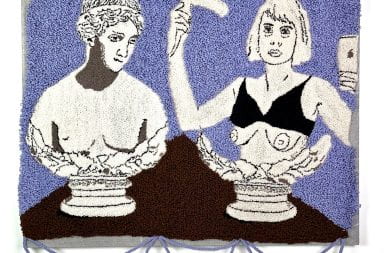
A member of the audience asks Abosede George a question during the event Q&A. Credit: Abigail Rice | Lantern reporter
Human Rights in Transit, an Ohio State sponsored research group, presented a public symposium Thursday called “Girls of Color: Resistance and the Politics of Empowerment,” headlined by social justice reform advocates.
“The goal of the symposium [was] to bring into critical conversation scholars whose work focuses on social justice, critical literacy, and community leadership for girls of color,” said Wendy Hesford, a professor of English and event organizer.
In her morning keynote address, Jasmine Sankofa, the Aryeh Neier Fellow at Human Rights Watch and the American Civil Liberties Union, spoke of her time spent advocating for girls at Central Juvenile Hall, a youth detention center in Los Angeles. There, she met a young girl incarcerated for prostitution after being exploited when she was only 10 years old.
Sankofa said this girl, and others in similar situations, motivated her to begin writing about domestic sex trafficking.
“After hearing my clients’ stories, I couldn’t help but wonder why they were arrested and detained in the first place,” she said. “I was disturbed that these girls were being incarcerated under the guise of protection.”
While Sankofa noted the Trafficking Victims Protection Act of 2000, as well as other efforts made to curb sex trafficking, she called attention to the injustice of racial disparities in anti-trafficking campaigns. And when viewed in light of arrest statistics, she said the disparities are particularly problematic.
Sankofa criticized the disproportionate relationship between the number of girls of color represented in anti-trafficking campaigns and the number imprisoned for sex-related crimes, most of which stem from unstable access to resources such as food, shelter, and support.
“The politics of protection have never protected [girls of color]. You see this when you view how the system interacts with those engaged with the sex trade,” Sankofa said. “Whether advocates want to admit it or not, lines are drawn between victims and nonvictims, good girls and bad, deserving and nondeserving. These dichotomies create a trap. And who falls in the cracks? Girls of color and LGBTQ youth.”
Sankofa stressed the importance of recognizing a highly punitive legal network as an alternative system of oppression for young girls.
The second keynote speaker, Abosede George, a professor of history and Africana studies at Barnard College and Columbia University, addressed the issue regarding representation of girls of color, but through the lens of a girl-saving campaign in northern Nigeria. In 2014, the hashtag #BringBackOurGirls went viral, demanding the safe return of the “Boko Haram wives,” a group of high-school-aged youth abducted by the Jihadist militant organization.
Whether advocates want to admit it or not, lines are drawn between victims and nonvictims, good girls and bad, deserving and nondeserving. These dichotomies create a trap. And who falls in the cracks? Girls of color and LGBTQ youth. – Jasmine Sankofa, Aryeh Neier Fellow at Human Rights Watch and the American Civil Liberties Union
Discussing the Western world’s motivation for participating in the campaign, George described U.S. activism as conditional, hinging on a gendered, often times fabricated, sense of danger — a problematic tool used to inspire salvationist impulses.
“For a moment, the Nigerian schoolgirls seemed to be claimed as everyone’s girls. When the bring back our girls hashtag first launched in 2014, the image that initially accompanied the slogan dramatized the theme of vulnerability,” George said.
The vulnerability narrative changed when Boko Haram released a video of these girls all uniformly dressed in dark hijabs, George said. Intense Islamophobia had replaced the image of the innocent schoolgirl with a homogenous, anonymous Muslim other.
“The limits of the popular vulnerability campaign began to be displayed in the resentment of the Chibok schoolgirls,” George said. She asked the question of “whether girl-saving campaigns inevitably rely on a narrowly gendered idea of girl whose defining feature is vulnerability to sexualized violence.”
George stressed the importance of giving these girls a voice — giving all girls a voice in how they are represented in these campaigns. Her discussion resonated with Sankofa’s, speaking to unacknowledged and systemic problems with the portrayal of girl victims.
Victoria Nash, a non-degree seeking student, said both dialogues impacted her perception of girlhood.
“There’s this idea of having empathy for the victim, this girl as the victim, but once she loses that girlhood, suddenly that empathy is gone,” Nash said. “Their access to assistance is gone. So that was very eye-opening.”


